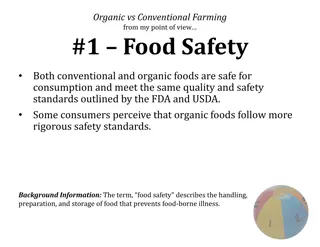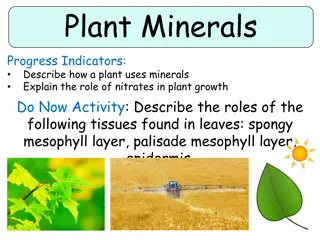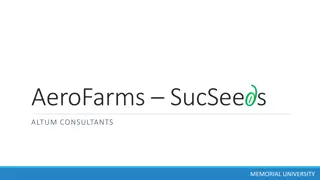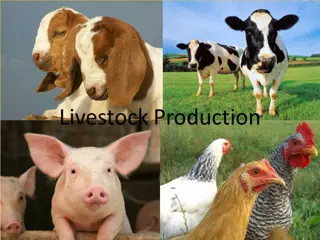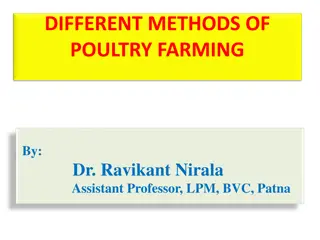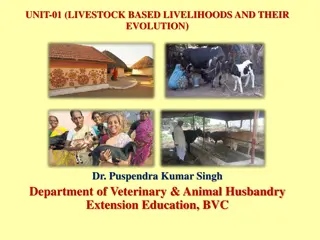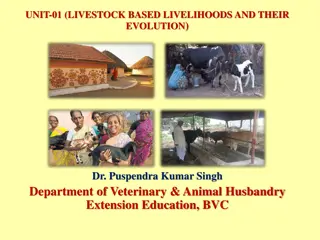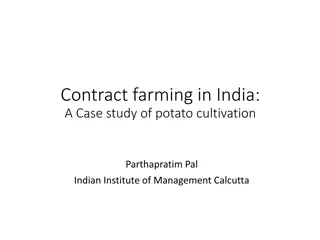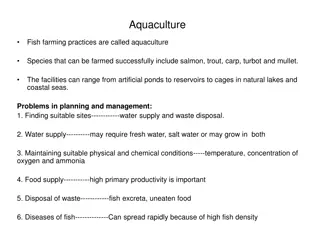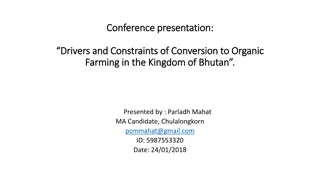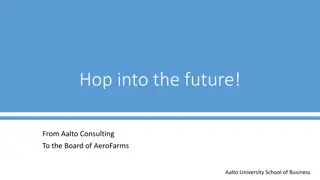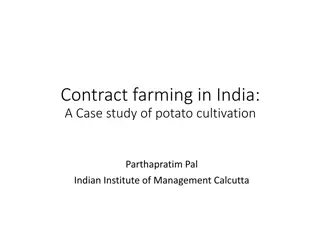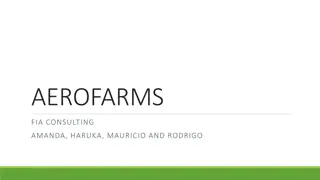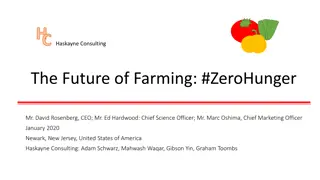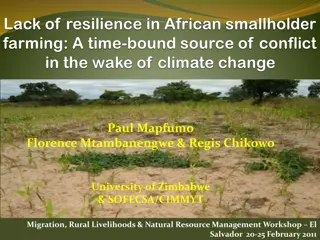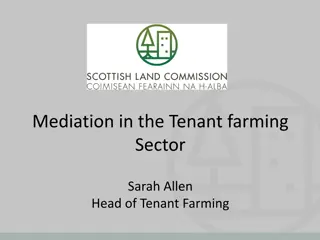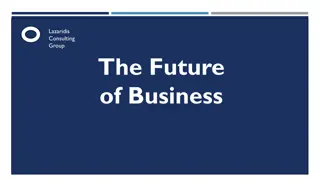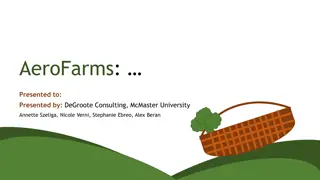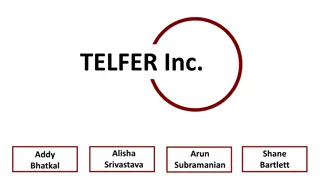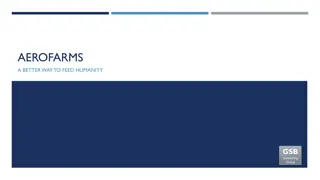AeroFarms and the Future of Farming
AeroFarms aims to revolutionize vertical farming for a sustainable future. The presentation outlines challenges, solutions, and recommendations for profitability, energy efficiency, and consumer awareness in vertical farming practices.
Download Presentation

Please find below an Image/Link to download the presentation.
The content on the website is provided AS IS for your information and personal use only. It may not be sold, licensed, or shared on other websites without obtaining consent from the author.If you encounter any issues during the download, it is possible that the publisher has removed the file from their server.
You are allowed to download the files provided on this website for personal or commercial use, subject to the condition that they are used lawfully. All files are the property of their respective owners.
The content on the website is provided AS IS for your information and personal use only. It may not be sold, licensed, or shared on other websites without obtaining consent from the author.
E N D
Presentation Transcript
C C C Carolina Consulting AeroFarms AeroFarms and the Future of Farming and the Future of Farming Presented to: AeroFarms Founders Ed Harwood, David Rosenberg, and Marc Oshima January 6, 2020 Presented by: Jason Cline, Will Richardson, Carly Seneca, Caroline Wright Overview Situation Analysis Recommendation Conclusion Implementation
C C Key Question Key Question How can AeroFarms become profitable and sustainable to make vertical farms the future? Reality Check: Unable to grow high- protein or high- calorie grains High energy-usage and carbon footprint No consumer awareness Overview Situation Analysis Recommendation Conclusion Implementation
C C Executive Summary Executive Summary How to feed an ever growing world population while climate change and human practices alter our environment Problem Develop a comprehensive plan to make vertical farming of vegetables a focal point in future farming practices Goal Alternatives Scale organically Acquire competition Form partnerships Brand & Industry Awareness Stakeholder Pushback Inability to Expand Crop Offerings Hurdles Energy Usage Overview Situation Analysis Recommendation Conclusion Implementation
C C Agenda Agenda Analysis Alternatives Recommendation Implementation Q&A Overview Situation Analysis Recommendation Conclusion Implementation
C C Qualifiers Qualifiers Stakeholder Buy-In Consumer Awareness Food Safety Standards Technology Know-How Overview Situation Analysis Recommendation Conclusion Implementation
C C Farming as necessary as air Farming as necessary as air Vertical Farming Traditional Farming Awareness of Vertical Farming Introduction Growth Maturity Decline Overview Situation Analysis Recommendation Conclusion Implementation
C C Goals and Objectives Goals and Objectives Key Stakeholders Definition of Success Key Performance Indicators Farmers Awareness Penetration Profitability Schools Consumers Community Organizations Governments Overview Situation Analysis Recommendation Conclusion Implementation
C C Timeframe Timeframe Awareness & Educational Campaigns Strategic Partnership Development City Expansion & Regional Rollout National Rollout Overview Situation Analysis Recommendation Conclusion Implementation
C C Data Hierarchy Data Hierarchy Our Competency Typical Competency Prescriptive Analytics Predictive Analytics Data Analytics Data Aggregation Data Collection Overview Situation Analysis Recommendation Conclusion Implementation
C C Decision Tree Decision Tree Organic growth The future of farming Acquire competition Government Form Traditional Farmers partnerships Stakeholders Overview Situation Analysis Recommendation Conclusion Implementation
C C Operating Landscape Operating Landscape Competitors Company Customers Overview Situation Analysis Recommendation Conclusion Implementation
C C Operating Landscape: Competitors Operating Landscape: Competitors Competitors Company Customers Overview Situation Analysis Recommendation Conclusion Implementation
C C Competitive Landscape Competitive Landscape High Revenue Industry Overview Agricultural Industry Non-traditional Methods Gotham Companies Aero Farms Bowery Farming Plenty Gotham Greens Bright Farms Lufa Farms Traditional Modern Bright Products Bowery Plenty Lufa Aeroponic Farming Hydroponic Farming Aquaponic Farming Low Revenue Overview Situation Analysis Recommendation Conclusion Implementation
C C Competitive Landscape Competitive Landscape Industry Overview Agricultural Industry Non-traditional Methods Strengths How We Win Knowledge of different techniques Alternative farming techniques Hire key talent in alternative farming Maximize innovative techniques Companies Bowery Farming Plenty Gotham Greens Bright Farms Lufa Farms Weaknesses Potential Landmines High energy usage Limited awareness Low cash flows Loss of funding Scale too quickly Loss of key stakeholder support Products Aeroponic Farming Hydroponic Farming Aquaponic Farming Overview Situation Analysis Recommendation Conclusion Implementation
C C Vertical Farming Regional Market Vertical Farming Regional Market Overview Situation Analysis Recommendation Conclusion Implementation
C C Vertical Farming in USA by Technology Vertical Farming in USA by Technology Overview Situation Analysis Recommendation Conclusion Implementation
C C Competition Competition Overview Situation Analysis Recommendation Conclusion Implementation
C C Operating Landscape: Customers Operating Landscape: Customers Competitors Company Customers Overview Situation Analysis Recommendation Conclusion Implementation
C C Customer Description Customer Description Consumers Schools Individuals Local governments Care about: Health Cost Sustainability Influenced by media, health trends, sustainability & cost Farmers Care about profitability, pride Impacted by political landscape Focus on job security Influenced by peers & tradition of farming within families Overview Situation Analysis Recommendation Conclusion Implementation
C C Operating Landscape: Company Operating Landscape: Company Competitors Company Customers Overview Situation Analysis Recommendation Conclusion Implementation
C C Internal Analysis Internal Analysis Why We Lose Why We Win Company Overview AeroFarm largest vertical farming company Prior strong funding rounds Extensive data analytics Well developed and standardized operating procedure Well developed crops regarding flavor and color Diverse leadership team Limited consumer awareness High energy usage Farmer pushback Potential loss of funding Limited crop variety Products Aeroponic Vertical Farming method Customers Schools Airlines Food Retailers Restaurants Overview Situation Analysis Recommendation Conclusion Implementation
C C Decision Tree Decision Tree Organic growth The future of farming Acquire competition Government Form Traditional Farmers partnerships Stakeholders Overview Situation Analysis Recommendation Conclusion Implementation
C C Decision Tree Decision Tree Organic growth The future of farming Acquire competition Government Form Traditional Farmers partnerships Stakeholders Overview Situation Analysis Recommendation Conclusion Implementation
C C Alternative #1: Government Partnerships Alternative #1: Government Partnerships PROS Partner with local governments to secure funding Secure source of funding Guaranteed customers through government agencies, local government, Grow presence in local schools ands community organizations CONS Creates extensive marketing to raise consumer awareness and education about vertical farming No direct way to expand growth and acquire knowledge Does not address high-calorie and high protein food issues Overview Situation Analysis Recommendation Conclusion Implementation
C C Alternative #2: Traditional Farmer Partnerships Alternative #2: Traditional Farmer Partnerships PROS Creates allies of stakeholders who would typically resist AeroFarms Keeps food sources local Creates a solution food needs outside of greens only Create incentives for farmers to partner with AeroFarms Transition traditional vegetable farming to AeroFarms to open up land and allow traditional farmers to focus on high- protein and high-calorie foods CONS Empowers farms to continue to feed the population while making use of land more sustainable Capital-intensive without government support Difficult to get farmers on board without a high consumer awareness and market buy-in Overview Situation Analysis Recommendation Conclusion Implementation
C C Alternative #3: Stakeholder Partnerships Alternative #3: Stakeholder Partnerships PROS Incentivize farmers to partner with AeroFarms and transition vegetable farming to AeroFarms to open up land for high-calorie and high-protein foods Solution for protein and high-calorie grain growth Community involvement ensures a market for farmers and both types of foods Empowers farmers through community awareness and knowledge of growing needed foods CONS Sustainability and health food focus in communities Capital intensive Farmer buy-in will be critical for success Overview Situation Analysis Recommendation Conclusion Implementation
C C Evaluation of Alternatives Evaluation of Alternatives Alternative #1: Government Partnerships Alternative #2: Traditional Farmer Partnerships Alternative #3: Key Stakeholder Partnerships Awareness Market Penetration Profitability Overview Situation Analysis Recommendation Conclusion Implementation
C C Decision Tree Decision Tree Organic growth The future of farming Acquire competition Government Form Traditional Farmers partnerships Stakeholders Overview Situation Analysis Recommendation Conclusion Implementation
C C Recommended Strategy Recommended Strategy Overview Situation Analysis Recommendation Conclusion Implementation
C C Why It Won t Work Why It Won t Work Key Concerns that could lead to failure Key Segments of Implementation Plan 1. No consumer interest or awareness 1. Awareness campaign & educational marketing plan 2. Traditional farmer pushback and lack of buy-in 2. Incentivization and empowerment of traditional farmers 3. Energy usage and costs 3. Long term LED efficiencies will improve dramatically (Moore s law) 4. Financial viability 4. Carbon offset funding partnerships Overview Situation Analysis Recommendation Conclusion Implementation
C C Implementation Overview: Step 1 Implementation Overview: Step 1 Awareness and Educational Marketing Campaign Strategic Partnership Development Regional Expansion of AeroFarms Facilities Overview Situation Analysis Recommendation Conclusion Implementation
C C Marketing Campaign Plan Marketing Campaign Plan Campaign 1: Vertical Farming & Aeroponics How it works? What is produced? Campaign 2: Key Players within Vertical Farming & Aeroponics Farmers Government Consumers Campaign 3: Impact Environment Consumer Lives Overview Situation Analysis Recommendation Conclusion Implementation
C C Marketing Plan Marketing Plan Marketing Mediums Marketing Mediums Traditional Television Ads Direct mail Billboards Point of Purchase/ In Store Signage Digital Mobile first Social Media Linked In, Instagram & Facebook Website Development Overview Situation Analysis Recommendation Conclusion Implementation
C C Implementation Overview: Step 2 Implementation Overview: Step 2 Awareness and Educational Marketing Campaign Strategic Partnership Development Regional Expansion of AeroFarms Facilities Overview Situation Analysis Recommendation Conclusion Implementation
C C Partnership Development Partnership Development Farmers Consumers Government Universities Retailers Overview Situation Analysis Recommendation Conclusion Implementation
C C Implementation Overview: Step 3 Implementation Overview: Step 3 Awareness and Educational Marketing Campaign Strategic Partnership Development Regional Expansion of AeroFarms Facilities Overview Situation Analysis Recommendation Conclusion Implementation
C C Regional Expansion Regional Expansion East Coast Expansion Locations of AeroFarms Phase 1: Camden, NJ, Southern New Jersey Phase 2: Philadelphia, PA, Baltimore, MD, Washington, D.C. Introduction to West Coast: Key Locations Phase 3: San Francisco, San Diego, Los Angeles (CA) Two Key Factors: Focus on suburbs 30-45 miles outside major metropolises to maintain financial viability Positive performance of regional expansion will support recommendation of a national expansion Overview Situation Analysis Recommendation Conclusion Implementation
C C Budget Budget Overview Situation Analysis Recommendation Conclusion Implementation
C C Timeline Timeline Overview Situation Analysis Recommendation Conclusion Implementation
C C KPI s & Metrics KPI s & Metrics Overview Situation Analysis Recommendation Conclusion Implementation
C C Logistical solution for farmers Logistical solution for farmers Many customers Lots of equipment Often high inventory of crops High land usage for vegetable crops Highly impacted by political policies and trade wars Traditional Farming today Less equipment Less supplies More pride and empowerment in being part of the food of the future movement Additional profit potential from AeroFarms profitability long-term Traditional Farmers with vertical farming in the future Overview Situation Analysis Recommendation Conclusion Implementation
C C Risks & Mitigations Risks & Mitigations Likelihood & Severity Risks Mitigations Consumers do not buy as much as expected Extensive marketing campaigns for awareness and education of both consumers and farmers No or little farmer buy-in Education and empowerment of farmers in addition to long-term partnerships High energy costs Moore s Law energy usage will drastically reduce as technology advances Financial problems or lack of capital Partner with governments and get funding from other sources such as offsets Overview Situation Analysis Recommendation Conclusion Implementation
C C Slide Index Slide Index Title Key Question Executive Summary Agenda Qualifiers Story Goals and Objectives Overview Situation Analysis Recommendation Conclusion Implementation



